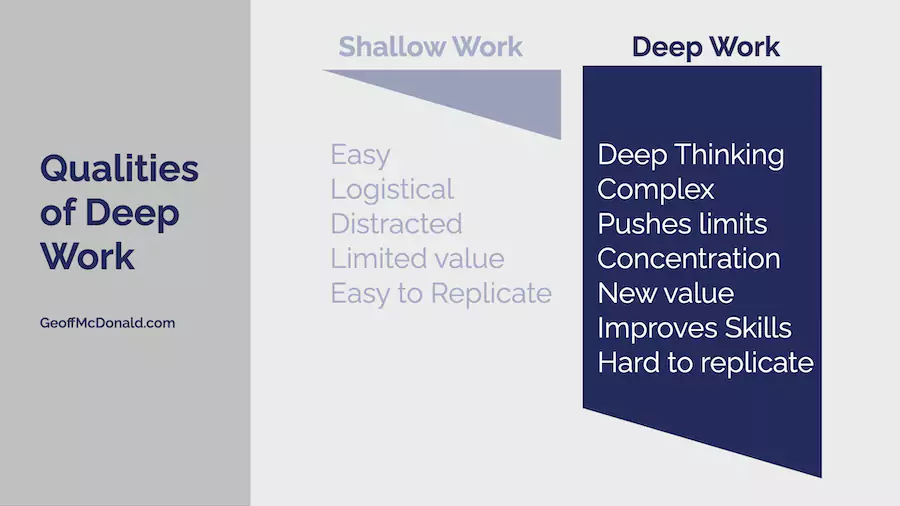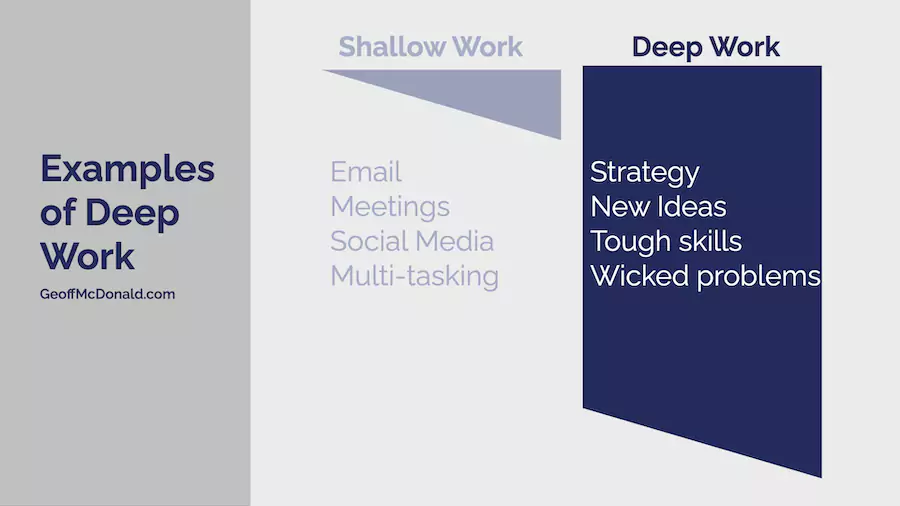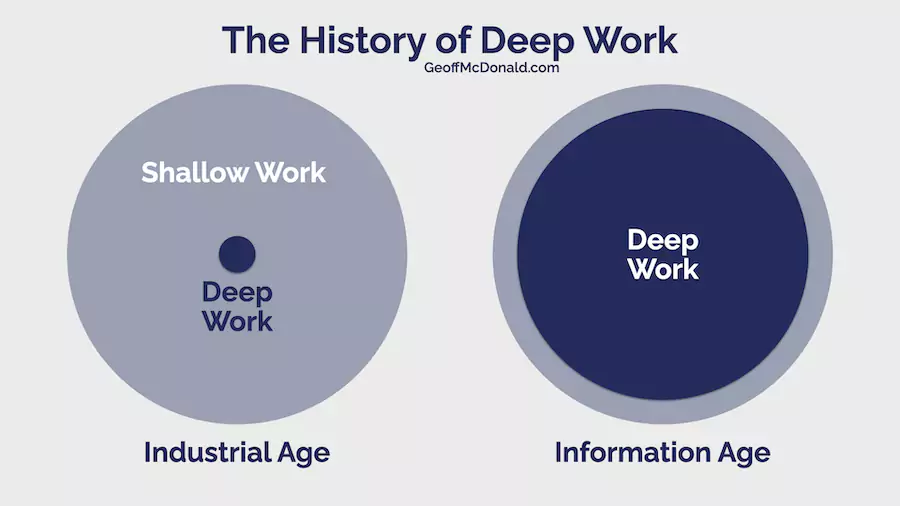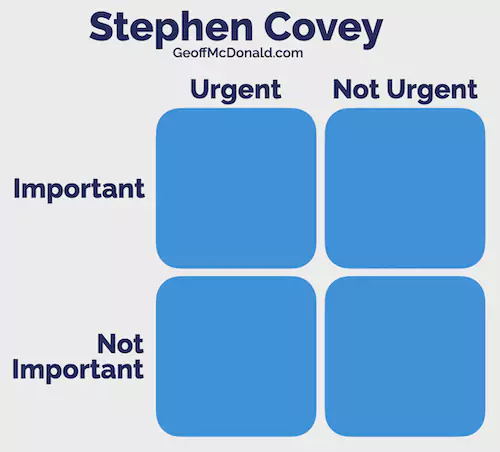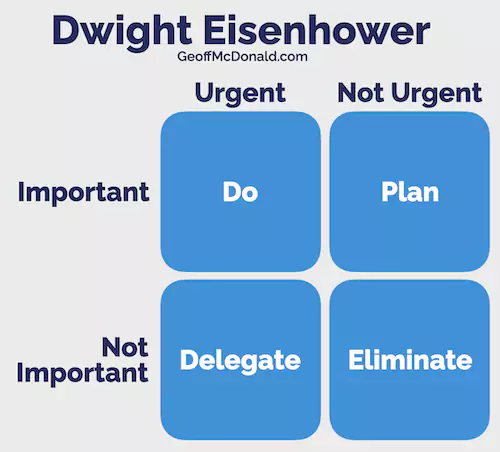Why Deep Work is a Genuine Thought Leadership Example
How do you become a thought leader? How do you earn money from what you know and be rewarded for the years you have spent gaining experience and growing your expertise?
In this post, we’ll look at the thought leadership example of Cal Newport and his book, Deep Work. From this, I’ll share five lessons you can take from Cal’s career that you can use to help you on your thought leadership journey.
What is Deep Work?
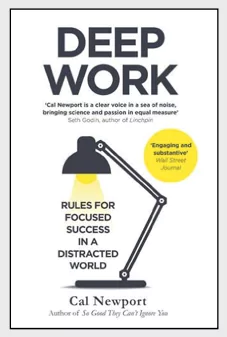
Plus, what I’m about to share comes from the book summary I created over at Book Rapper of Cal’s book Deep Work.
I even referred to Deep Work in the post Thought Leadership Meaning – it’s a great reference for the type of work that Thought Leaders do.
Can you tell I love this book?
Let’s start with the obvious question: What is Deep Work?
Here’s how Cal Newport defined Deep Work in an interview with Lex Fridman:
So I mean, it’s my term for when you’re focusing without distraction on a cognitively demanding task, which is something we’ve all done, but we had never really given it a name, necessarily that was separate from other types of work. And so I gave it a name and said, Let’s compare that to other types of efforts you might do while you’re working
Deep Work and Shallow Work
Deep work is such a beautiful simple term – two everyday four-letter words – and it leads to an obvious contrast between deep work and shallow work.
Shallow work is:
- Easy to do
- Logistical – for example making an appointment or scheduling a meeting
- You can do shallow work while you are distracted eg listening to music or talking with other people
- Has limited value
- Easy to replicate
In contrast, Deep Work:
- Deep thinking
- It’s about complex things
- It pushes you to your limits
- Requires a high level of concentration
- Provides new value
- Improves your skills
- Is hard to replicate
Examples of Deep Work and Shallow Work
Examples of Shallow Work include: Email, Meetings, Social Media and Multi-tasking (any task you can do while also doing something else)
Examples of Deep Work include: Defining strategy, Coming up with new ideas, Building tough skills and Working on wicked problems
The History of Deep Work
One thing Cal Newport says in his book is that Deep Work is not a new thing.
In the Industrial Age, most of the work was shallow work. It was people in factories making widgets. The work was easy to learn, tended to be repetitive and most importantly didn’t require a lot of brainpower. Only a handful of people – the educated elite – did Deep Work and they tended to make the decisions that other people followed.
In the Information Age, this has flipped. Now, most of our work requires deep thinking because we are dealing with ideas and information and not widgets.
The Deep Work Hypothesis
Why is this important? Cal Newport points out that the value of Deep Work has risen substantially in recent years. This is multiplied because the work has a high level of impact and so few people are doing it.
Your Career Choice
This leaves you with an important career choice to make.
You can either do valuable work and be well rewarded or you can do mediocre work, be poorly rewarded and more than likely replaced by a machine.
Which ones is it going to be?
Who is Cal Newport?

I included Cal Newport in the previous post, What is Thought Leadership? Seven Thought Leadership Examples. I used him as a unique example of thought leadership in that post.
Cal Newport is a computer science professor at Georgetown University. He has published over 60 peer-reviewed articles that have been cited over 3500 times. That’s a strong academic career.
But that’s not why we’re talking about him today.
Cal is also the author of seven New York Times best-selling books. And while I have read most of his books and a lot of his blog posts, I know almost nothing about his career as a professor of computer science.
For me, and many people around the world, Cal Newport is better known for his side-hustle rather than his day job.
In 2007, while still a graduate student, Cal started blogging about study methods. This has morphed into a series of books on the intersection of digital technology and culture.
Is this a genuine Thought Leadership Example?
How would we know if this was a genuine thought leadership example?
To answer this question, we need some measures or benchmarks to consider.
In my previous post on Thought Leadership Strategy, I shared the three essential things every thought leader needs to build. They are:
- Money or financial capital
- Ideas or intellectual capital
- People or social capital
This gives us three basic questions to consider whether someone is a thought leader or not.
- Do you earn money from your ideas?
- Do you design, build and share your ideas?
- Are other people using your ideas?
Cal Newport easily meets these three criteria: he writes books based on his own ideas and his work has attracted a worldwide audience.
Many people would meet these criteria. Where it gets interesting is at what level. One measure of success is:
- How much money do you earn
- The depth and breadth of your ideas
- Plus the number, volume and influence levels of the people that follow and use your ideas.
How to become a thought leader
What can we learn from Cal Newport about how to become a thought leader?
Now let’s look at this in more detail. Here are five lessons to take home and apply to your career.
1 Is it an Original Idea?
The big mistake I often find when talking with clients and colleagues is they think they must come up with a totally unique and original idea.
That does happen but it’s rare. And it’s not necessary.
Cal Newport admits he is not the first to talk about Deep Work.
This is evident in the Google Ngrams (left) and Google Trends (right) searches that I did. [Ngrams measures the number of references for a term in books, Google Trends measures the number of searches for a given term.]
I think the question about originality is the wrong one. It’s more important that your idea shifts the context that your audience is operating from.
I spoke about this in the earlier post when I suggested that Context Shifting was the most important skill a Thought Leader could develop.
This occurs when you label the context you are operating from in a new way. This sets up new possibilities, new opportunities and new actions.
You can then shift the context by applying an existing idea in a new way and that’s what I’d say Cal Newport has done here with Deep Work. He has rebirthed an old idea that provides fresh insight into how to be successful today.
Our big lesson here is: don’t fuss about being original.
2 How does Deep Work provide a Context Shift?
I’m going to add my own interpretation here. This is not something that Cal Newport has spoken about. What I want to show is a comparison of similar ideas to show how Cal Newport has re-labelled things to create a context shift.
You might have seen this one before… In his super popular book, The Seven Habits of Highly Effective People, Stephen Covey used this matrix to help us to decide what to work on.
Covey’s diagram originally came from General Eisenhower who later became US President. His diagram looked like this. It’s the same matrix but with labels added to each of the squares.
While not a perfect fit, I think Cal Newport has given us fresh insight because he has given us new labels for these areas of work. He is saying Deep Work is your important but not urgent work. And your Shallow Work is often urgent but not important which means you should be doing more deep work and less shallow work.
Our big lesson here is: Instead of trying to be original, focus on creating a context shift. Focus on the value you create, not the merit of the idea.
3 How can someone buy your idea?
If you want people to buy your ideas, you must give them form. In other words, you need to package it up in a way that it can be bought as a product or service.
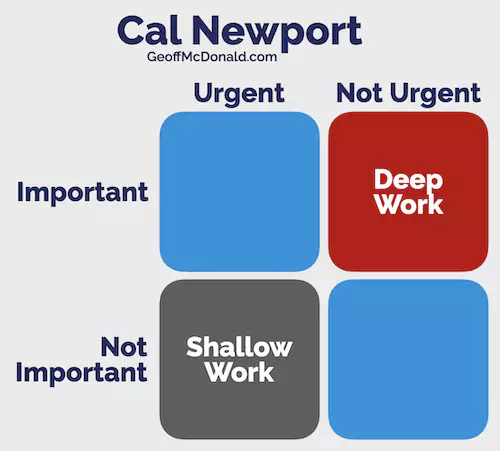
Our big lesson here is: Give your idea form so people can buy it.
4 Do other people use this idea?
Yes, and I’m one of those people. I have designed my life, my business and my work around doing Deep Work. These posts are a demonstration of this – they are the output of my Deep Work. (I use the Pomodoro method to do my deep thinking through short high concentration blocks of time.)
We can also find plenty of other evidence that shows people engaging with and using his ideas:
- The book is a New York Times Bestseller
- His personal website and blog have a domain authority of 65 which is very high for an individual. This means a lot of people read his work online.
- On YouTube, there are hundreds of videos of people talking about Deep Work.
While none of these is conclusive stats they do point to a strong following.
Our big lesson here is: To grow an audience you need to share your ideas with others regularly.
5 How did Cal Newport come up with Deep Work?
If you want to become a thought leader, there is no escaping the simple truth that you need to do the work.
While I don’t know the specific trigger for the ‘deep work’ concept, it’s clear that Cal Newport has done the work.
- First, he has a full-time job as a professor at a university. For most of us, this would be enough.
- He has also written over 1100 blog posts since August 2007. That’s at least one blog post a week for 14 years.
- Plus, he has written seven books and numerous articles.
- He also has a podcast and YouTube channel.
From my experience, when you engage with an idea by writing about it and sharing it then it evolves. In this case, it’s evolved into something big.
Our big lesson here is: If you want to be a thought leader then you can’t escape the basic truth: you need to do the work.
Summary: Why Deep Work a Genuine Thought Leadership Example
Let’s wrap up what we’ve covered here…
Deep Work is a Genuine Thought Leadership Example because it meets our three thought leadership criteria:
- Do you earn money from your ideas?
- Do you design, build and share your ideas?
- Plus, do other people use your ideas?
Cal earns money from his idea through books sales. He has designed, built and shared his idea through his blog and in his book. And other people, like me, use his idea in their daily lives.
The five lessons you can apply to your thought leadership journey are:
- Don’t fuss about being original
- Instead, focus on creating a context shift
- Give your idea form so people can buy it
- Share your ideas with others regularly
- Do the work
One more thing…
Wait, there’s one more thing I need to add…
Stop using the excuse that you don’t have time to do the work that matters. Bottom line: You have the time.
If you don’t think you have time to do the work consider Cal’s situation:
- He has a full-time job
- Writes his blog and his books on the side.
- Is devoted to his family
- He doesn’t work in the evenings
It is also worth noting that Cal Newport has never owned a social media account. He doesn’t spend his time promoting himself.
What are you spending your life doing today? You have the time.
More Thought Leadership Examples and Ideas
Here are some links to related content on Thought Leadership Examples and how to become a thought leader:
- How to Become a Thought Leader
- The most important thought leadership skills to develop
- The best types of thought leadership content to create
Add a comment: Why do you think Deep Work has become such a successful idea?

